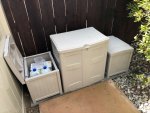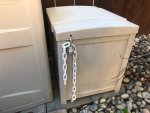There is a lot of different threads on chemical storage so I compiled the "preferred" methods and seek clarification on some. Please comment on your storage and best practice.
Muriatic Acid (MA) - everyone agrees it is corrosive and should be stored separately and preferably outside in a plastic storage box - it has a relatively long shelf life regardless of temperature. Keep away from metal and store by itself.
Borax or Baking Soda - keep dry, moisture free environment - mainly inside such as utility or laundry room on a shelf or in basement - good shelf life
Dry Chlorine (i.e. pucks or granular) also known as Dichlor, Trichlor or Calcium hypochlorite (cal hypo) - Keep in its storage container from store - store in dry area - can be stored in garage or basement but best if outside as some chlorine vapor can be corrosive - good shelf life due to the CYA included (in dichlor and trichlor only)
Liquid Chlorine (in gallon plastic bottles) - known as Sodium Hypochlorite (or bleach) - comes in varying percentage of sodium hypochlorite denoted on the bottle. - Keep in cool place - many store in utility or laundry room if not in high quantities (due to space). Can also be stored outside in garage or in separate container or storage shed. Liquid Chlorine (% sodium hypochlorite) will deteriorate over time due to heat and does not have long shelf life. Liquid Chlorine should NOT be stored with MA (in same storage shed) .
Questions
1) Can Dry Chlorine and Liquid Chlorine be stored in the same outside storage container or shed? If not, what is the concern since both would give off Chlorine gas?
2) Can MA be stored with dry chlorine in the same outside storage container or shed? Maybe on separate shelfs or 2-3 apart from each other. I read some do this but not sure that is ideal.
Feel free to post other questions for experts to clarify.
Muriatic Acid (MA) - everyone agrees it is corrosive and should be stored separately and preferably outside in a plastic storage box - it has a relatively long shelf life regardless of temperature. Keep away from metal and store by itself.
Borax or Baking Soda - keep dry, moisture free environment - mainly inside such as utility or laundry room on a shelf or in basement - good shelf life
Dry Chlorine (i.e. pucks or granular) also known as Dichlor, Trichlor or Calcium hypochlorite (cal hypo) - Keep in its storage container from store - store in dry area - can be stored in garage or basement but best if outside as some chlorine vapor can be corrosive - good shelf life due to the CYA included (in dichlor and trichlor only)
Liquid Chlorine (in gallon plastic bottles) - known as Sodium Hypochlorite (or bleach) - comes in varying percentage of sodium hypochlorite denoted on the bottle. - Keep in cool place - many store in utility or laundry room if not in high quantities (due to space). Can also be stored outside in garage or in separate container or storage shed. Liquid Chlorine (% sodium hypochlorite) will deteriorate over time due to heat and does not have long shelf life. Liquid Chlorine should NOT be stored with MA (in same storage shed) .
Questions
1) Can Dry Chlorine and Liquid Chlorine be stored in the same outside storage container or shed? If not, what is the concern since both would give off Chlorine gas?
2) Can MA be stored with dry chlorine in the same outside storage container or shed? Maybe on separate shelfs or 2-3 apart from each other. I read some do this but not sure that is ideal.
Feel free to post other questions for experts to clarify.


 THANKS!
THANKS!

